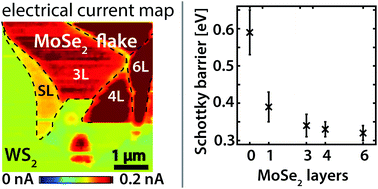Control of the metal/WS2 contact properties using 2-dimensional buffer layers†
Abstract
Transition metal dichalcogenides (TMDC) have recently attracted much attention as a promising platform for the realization of 2-dimensional (2D) electronic devices. One of the major challenges for their wide-scale application is the control of the potential barrier at the metal/TMDC junction. Using conductive atomic force microscopy (c-AFM) we have investigated modifications of the Schottky barrier height (SBH) across a Pt/WS2 junction by the introduction of thin buffer layers of graphene and MoSe2. While graphene greatly reduces the contact resistance in both bias directions, thin layers of MoSe2 lower the Schottky barrier and leave the rectifying properties of the junction intact. We have studied the dependence of the transport properties on the thickness of the graphene and MoSe2 buffer layers. In both cases, the charge transport characteristics can be tailored by varying the buffer layer thickness. The edge of single layer graphene is observed to form an ohmic contact to the underlying WSe2 substrate. This study demonstrates that the introduction of atomically thin MoSe2 and graphene buffer layers is a feasible and elegant method to control the Schottky barrier when contacting TMDCs. The results are important for the fabrication of devices utilizing 2D materials.



 Please wait while we load your content...
Please wait while we load your content...